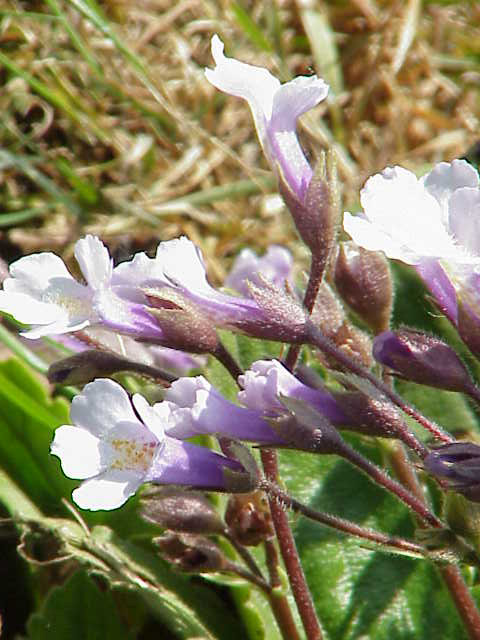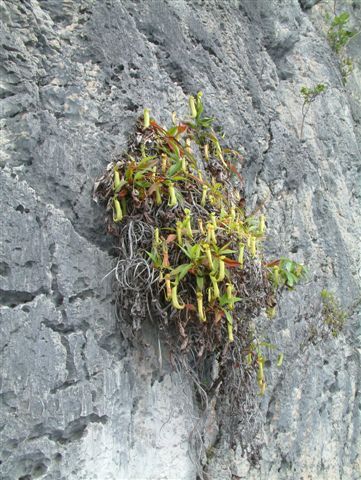|
Amalophyllon Miraculum
''Amalophyllon miraculum'' is a plant species in the family Gesneriaceae endemic to the Andes of Ecuador. It was discovered in Centinela, Ecuador in 2024. The plant is small in stature and an obligate lithophyte Lithophytes are plants that grow in or on rocks. They can be classified as either epilithic (or epipetric) or endolithic; epilithic lithophytes grow on the surfaces of rocks, while endolithic lithophytes grow in the crevices of rocks (and are als .... It lives near waterfalls due to its need of constant moisture. This small plant with serrated leaves and tiny white flowers is named "miraculum" because its miraculous the species was still there after being thought to be extinct. References Gesnerioideae Plants described in 2024 Endemic flora of Ecuador Lithophytes {{Gesneriaceae-stub ... [...More Info...] [...Related Items...] OR: [Wikipedia] [Google] [Baidu] |
Species
A species () is often defined as the largest group of organisms in which any two individuals of the appropriate sexes or mating types can produce fertile offspring, typically by sexual reproduction. It is the basic unit of Taxonomy (biology), classification and a taxonomic rank of an organism, as well as a unit of biodiversity. Other ways of defining species include their karyotype, DNA sequence, morphology (biology), morphology, behaviour, or ecological niche. In addition, palaeontologists use the concept of the chronospecies since fossil reproduction cannot be examined. The most recent rigorous estimate for the total number of species of eukaryotes is between 8 and 8.7 million. About 14% of these had been described by 2011. All species (except viruses) are given a binomial nomenclature, two-part name, a "binomen". The first part of a binomen is the name of a genus to which the species belongs. The second part is called the specific name (zoology), specific name or the specific ... [...More Info...] [...Related Items...] OR: [Wikipedia] [Google] [Baidu] |
Gesneriaceae
Gesneriaceae, the gesneriad family, is a family (biology), family of flowering plants consisting of about 152 genera and ca. 3,540 species in the tropics and subtropics of the Old World (almost all Didymocarpoideae) and the New World (most Gesnerioideae), with a very small number extending to temperate areas. Many species have colorful and showy flowers and are cultivated as ornamental plants. Etymology The family name is based on the genus ''Gesneria'', which honours Switzerland, Swiss naturalist and humanism, humanist Conrad Gessner. Description Most species are herbaceous plant, herbaceous perennial plant, perennials or subshrubs but a few are woody shrubs or small trees. The phyllotaxy is usually opposite and decussate, but leaves have a spiral or alternate arrangement in some groups. As with other members of the Lamiales the flowers have a (usually) zygomorphic corolla whose petals are fused into a tube and there is no one character that separates a gesneriad from any o ... [...More Info...] [...Related Items...] OR: [Wikipedia] [Google] [Baidu] |
Endemic
Endemism is the state of a species being found only in a single defined geographic location, such as an island, state, nation, country or other defined zone; organisms that are indigenous to a place are not endemic to it if they are also found elsewhere. For example, the Cape sugarbird is found exclusively in southwestern South Africa and is therefore said to be ''endemic'' to that particular part of the world. An endemic species can also be referred to as an ''endemism'' or, in scientific literature, as an ''endemite''. Similarly, many species found in the Western ghats of India are examples of endemism. Endemism is an important concept in conservation biology for measuring biodiversity in a particular place and evaluating the risk of extinction for species. Endemism is also of interest in evolutionary biology, because it provides clues about how changes in the environment cause species to undergo range shifts (potentially expanding their range into a larger area or bec ... [...More Info...] [...Related Items...] OR: [Wikipedia] [Google] [Baidu] |
Andes
The Andes ( ), Andes Mountains or Andean Mountain Range (; ) are the List of longest mountain chains on Earth, longest continental mountain range in the world, forming a continuous highland along the western edge of South America. The range is long and wide (widest between 18th parallel south, 18°S and 20th parallel south, 20°S latitude) and has an average height of about . The Andes extend from south to north through seven South American countries: Argentina, Chile, Bolivia, Peru, Ecuador, Colombia, and Venezuela. Along their length, the Andes are split into several ranges, separated by intermediate depression (geology), depressions. The Andes are the location of several high plateaus—some of which host major cities such as Quito, Bogotá, Cali, Arequipa, Medellín, Bucaramanga, Sucre, Mérida, Mérida, Mérida, El Alto, and La Paz. The Altiplano, Altiplano Plateau is the world's second highest after the Tibetan Plateau. These ranges are in turn grouped into three majo ... [...More Info...] [...Related Items...] OR: [Wikipedia] [Google] [Baidu] |
Ecuador
Ecuador, officially the Republic of Ecuador, is a country in northwestern South America, bordered by Colombia on the north, Peru on the east and south, and the Pacific Ocean on the west. It also includes the Galápagos Province which contains the Galapagos Islands in the Pacific, about west of the mainland. The country's Capital city, capital is Quito and its largest city is Guayaquil. The land that comprises modern-day Ecuador was once home to several groups of Indigenous peoples in Ecuador, indigenous peoples that were gradually incorporated into the Inca Empire during the 15th century. The territory was Spanish colonization of the Americas, colonized by the Spanish Empire during the 16th century, achieving independence in 1820 as part of Gran Colombia, from which it emerged as a sovereign state in 1830. The legacy of both empires is reflected in Ecuador's ethnically diverse population, with most of its million people being mestizos, followed by large minorities of Europe ... [...More Info...] [...Related Items...] OR: [Wikipedia] [Google] [Baidu] |
Centinela Del Cóndor Canton
Centinela del Cóndor Canton is a canton of Ecuador, located in the Zamora-Chinchipe Province Zamora Chinchipe (), Province of Zamora Chinchipe is a province of the Republic of Ecuador, located at the southeastern end of the Amazon Basin, which shares borders with the Ecuadorian provinces of Azuay and Morona Santiago to the north, Loja .... Its capital is the town of Zumbi. Its population at the 2001 census was 7,230. at statoids.com References Cantons of Zamora-Chinchipe Province {{Ecuador-geo-stub ...[...More Info...] [...Related Items...] OR: [Wikipedia] [Google] [Baidu] |
Lithophyte
Lithophytes are plants that grow in or on rocks. They can be classified as either epilithic (or epipetric) or endolithic; epilithic lithophytes grow on the surfaces of rocks, while endolithic lithophytes grow in the crevices of rocks (and are also referred to as chasmophytes). Lithophytes can also be classified as being either obligate or facultative. Obligate lithophytes grow solely on rocks, while facultative lithophytes will grow partially on a rock and on another substrate simultaneously. Nutrients Lithophytes that grow on land feed off nutrients from rain water and nearby decaying plants, including their own dead tissue. It is easier for chasmophytes to acquire nutrients because they grow in fissures in rocks where soil or organic matter has accumulated. For most lithophytes, nitrogen is only available through interactions with the atmosphere. The most readily available form of nitrogen in the atmosphere is the gaseous state of ammonia (NH3). Lithophytes consume atmospheric ... [...More Info...] [...Related Items...] OR: [Wikipedia] [Google] [Baidu] |
Gesnerioideae
The Gesnerioideae are a subfamily of plants in the family Gesneriaceae: based on the type genus ''Gesneria''. Although genera typically originate in the New World, some species have become widely distributed as ornamental plants. Description Gesnerioideae is one of two main subfamilies in the Gesneriaceae, the other being Didymocarpoideae. (The third subfamily, Sanangoideae, contains only the genus ''Sanango''.) Gesnerioideae seedlings have normal cotyledons of the same size and shape (isocotylous), whereas the cotyledons of Didymocarpoideae are usually, but not always, eventually different in size and shape (anisocotylous). Gesnerioideae flowers usually have four fertile stamens, rarely two or five. In other respects, Gesnerioideae species are very variable. The Ovary (botany), ovary may be superior, semi-inferior or inferior, and the fruit takes various forms. Taxonomy The original use of the name for the subfamily is attributed to Gilbert Thomas Burnett in 1835. Burnett divide ... [...More Info...] [...Related Items...] OR: [Wikipedia] [Google] [Baidu] |
Plants Described In 2024
Plants are the eukaryotes that form the kingdom Plantae; they are predominantly photosynthetic. This means that they obtain their energy from sunlight, using chloroplasts derived from endosymbiosis with cyanobacteria to produce sugars from carbon dioxide and water, using the green pigment chlorophyll. Exceptions are parasitic plants that have lost the genes for chlorophyll and photosynthesis, and obtain their energy from other plants or fungi. Most plants are multicellular, except for some green algae. Historically, as in Aristotle's biology, the plant kingdom encompassed all living things that were not animals, and included algae and fungi. Definitions have narrowed since then; current definitions exclude fungi and some of the algae. By the definition used in this article, plants form the clade Viridiplantae (green plants), which consists of the green algae and the embryophytes or land plants (hornworts, liverworts, mosses, lycophytes, ferns, conifers and other gymnosperm ... [...More Info...] [...Related Items...] OR: [Wikipedia] [Google] [Baidu] |




